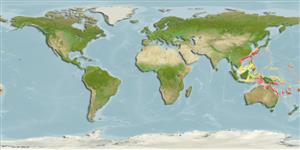>
Perciformes/Serranoidei (Groupers) >
Anthiadidae (Fairy basslets or Streamer basses)
Etymology: Plectranthias: Greek, plektron = anyhting to strike with, spur + Greek, anthias = a fish, Sparus aurata (Ref. 45335).
Environment: milieu / climate zone / depth range / distribution range
Écologie
marin récifal; profondeur 80 - 300 m (Ref. 26833). Subtropical
Western Pacific.
Taille / Poids / Âge
Maturity: Lm ? range ? - ? cm
Max length : 11.1 cm SL mâle / non sexé; (Ref. 40960)
Rayons mous dorsaux (Total): 17. Body moderately deep, depth 2.3 in SL. Head not completely scaled. Ventral margin of preopercle with no antrorse spine (Ref. 43101). Second soft dorsal not filamentous and third dorsal spine longest. Second branched caudal rays filamentous and a small red spot on the upper base of caudal fin. Body with 2 oblique red bands and a third narrow one from eye to thorax (Ref. 26833).
Life cycle and mating behavior
Maturité | Reproduction | Frai | Œufs | Fécondité | Larves
Chen, J.-P. and K.-T. Shao, 2002. Plectranthias sheni, a new species and P. kamii, a new record of anthiine fishes (Perciformes: Serranidae) from Taiwan. Zool. Stud. 41(1):63-68. (Ref. 43101)
Statut dans la liste rouge de l'IUCN (Ref. 130435)
Menace pour l'homme
Harmless
Utilisations par l'homme
Plus d'informations
PaysZones FAOÉcosystèmesOccurrencesIntroductionsStocksÉcologieRégime alimentaireÉléments du régime alimentaireConsommation alimentaireRation
Noms communsSynonymesMétabolismePrédateursÉcotoxicologieReproductionMaturitéFraiRassemblement de ponteFéconditéŒufsDéveloppement de l'œuf
RéférencesAquacultureProfil d'aquacultureSouchesGénétiqueElectrophoresesHéritabilitéPathologiesTraitementNutrientsMass conversion
Outils
Articles particuliers
Télécharger en XML
Sources Internet
Estimates based on models
Preferred temperature (Ref.
123201): 16.7 - 26.4, mean 20.2 °C (based on 75 cells).
Phylogenetic diversity index (Ref.
82804): PD
50 = 0.5000 [Uniqueness, from 0.5 = low to 2.0 = high].
Niveau trophique (Ref.
69278): 4.0 ±0.6 se; based on size and trophs of closest relatives
Résilience (Ref.
120179): Haut, temps minimum de doublement de population inférieur à 15 mois (Preliminary K or Fecundity.).
Fishing Vulnerability (Ref.
59153): Low vulnerability (10 of 100).
